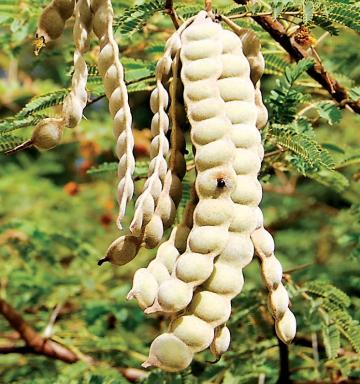
Babul pods, seeds and babul seed chuni (Acacia nilotica)
Common name: Gum Arabic
Local names: Hindi: Babool, Kikar Marathi: Babul Telugu: Nallatumma, Kannada: Babli, Malayalam: Karivelam, Tamil: Karuvelai Gujarati: Babaria
Babul is a medium to large tree, native to West Asia, can reach a height of 10 m, with an average of 4-7 m in height. This tree grows in dry regions like Haryana, Punjab, Uttaranchal, Uttar Pradesh, Rajasthan, Madhya Pradesh, Maharashtra, Gujarat and many more states of India. Babul seeds contain gum. Large quantities of extracted (degummed) babul seeds are available for feeding livestock. Babul seed extraction (meal) is available after extraction of oil from babul seeds. Babul seeds are separated from pods and are ground and available as babul seed chuni
Availability
Babul pods are available in plenty. Approximately 6 lakh tones babul pods (Feedstuffs, 2005) and 60,000 tones babul seeds are annually available in India.
Nutritive value
Babul pod contains 12% CP and 55% TDN. Pod contains 56.50% RDP and 43.50% RUP or bypass protein (Feedstuffs, 2005). In terms of bypass protein, it is comparable to cottonseed meal and is highly beneficial for high-producing dairy cows. Babul seeds are moderate source of energy (TDN 59%). Babul seed chuni contains 16% CP and 55% TDN.
Deleterious factor
The extracted seeds contain about 5% tannins. Babul seed chuni contain 3% tannins which reduces the digestibility of CP in feed.
Inclusion
Due to its particular smell, babul seeds are not palatable as such to animals. But it is consumed by animals when mixed with more palatable conventional feeds. Babul seeds and babul pods chuni can be used up to 15% level in the concentrate mixture of lactating cows. These can be included at 39% level in the concentrate mixture of crossbred calves (Punj, 1988). Babul seed chuni can be used up to 30, 45 and 15% level in the ration of growing calves, adult bullocks and lactating cows, respectively (Talpada et al., 2002). Patel et al. (1982) found that incorporation of processed babul seeds at 15, 30 and 45% level in ration of kankrej bullocks resulted in lower CP digestibility and lower retention of nitrogen, calcium and phosphorus as compared to control. In scarcity period, babul pods and babul pods chuni can be used for feeding of animals to save the livestock. Babul pods must be ground before feeding to cattle, otherwise the seeds pass undigested with faeces.
